All 8 major moon icons can be found here in the section titled “Sky & Weather”.
(they definitely work in Google gauges as a header or footer, but untested as a majorTick)
Can you elaborate? What two data points are you comparing?

All 8 major moon icons can be found here in the section titled “Sky & Weather”.
(they definitely work in Google gauges as a header or footer, but untested as a majorTick)
Can you elaborate? What two data points are you comparing?
5 posts were split to a new topic: TWC - Sunrise/Set - Forecast & conditions slightly different
Whoops… Yesterday was the half-way point for Summer…
Here are my gauges today:
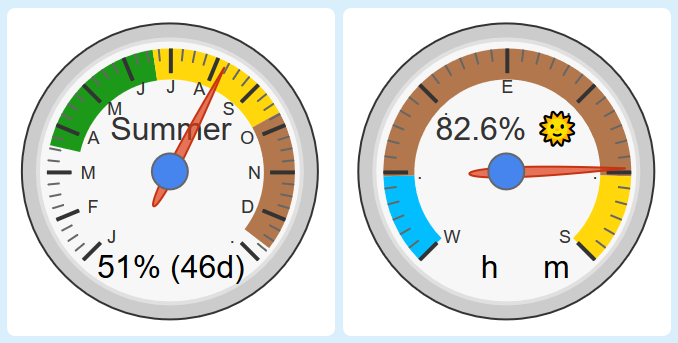
When referring to the “length of day”, we now begin the mid-quarter (Goldilocks) time period for the next 3 months. (meaning the days are neither too long or short)
Mathematically speaking, (depending on latitude), approx 83% > 17% is a quarter year.
(the day’s length changes the most dramatically during this quarter)
I like to think of the dial on the right as kind of like the dial on my oven… As Mother Nature turns the dial slowly downwards, (less sunlight), it begins to allow the air to cool off more and more…
Eventually, I plan on creating a similar gauge right next to this one that monitors the heat throughout the year. I think it’d be “cool” to see where we are along that timeline as well. 

My daylight appears to be tracking your gauge but my days seems to be off. I also added the moon phase to this display for fun.
Will have to take a look when I get the chance. I think all my first day of season calls use the 21st of the appropriate month. Also, there is no accounting for the leap day this year except in the ‘daysThisYear’ calculation.
Without access to a local API, late 20 or early 21 is likely the best number, statistically speaking.
(At it’s worst, it should be within 98.5% accuracy for all future Solstices & Equinoxes. IE: 1½ days)
My numbers will not match yours because I am pulling data from a custom file I created.
For me, this Fall Equinox falls on the 22nd:
![]()
… and my Summer Solstice was on the 20th.
(My math is based on the difference)
Does this percentage mean that tomorrow will no longer be “hot as hell”…?
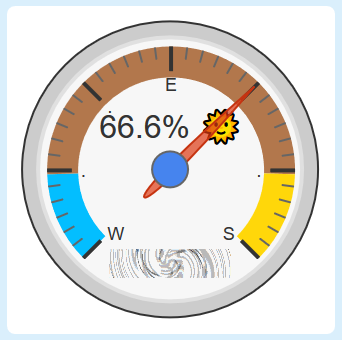
Apparently not… Looking at the temperature 24 hours later…
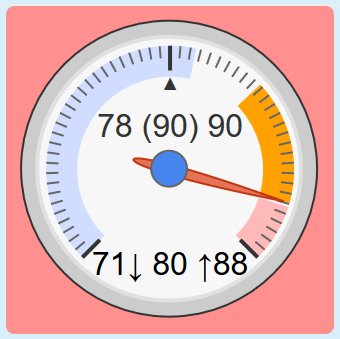
… we are only 6 degrees shy of our record high… 
We are about 9 hours away from the Fall Equinox…
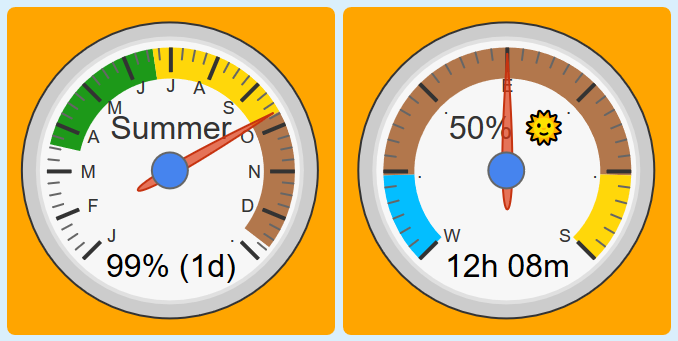
For those curious about the extra 8 min… 
For the truly equal day/night split, we’ll have to wait a few days after the official equinox.
(The equilux varies for all of us, based on latitude)
For a summary of that link, basically the 8 min for my location is about:
2.7 min due to the time it takes the radius to cross the horizon twice
(Equinox is based on the center point, and sunrise/set is based on the outer edge)
5.4 min due to the light refracting
(atmospheric refraction advances the sunrise and delays the sunset)
I missed th first day of fall as we were on a road trip at the time. I need to wait until December to get my true shortest day of the year to fix my scales. Right now, it already says 47.8% at 12h 2m day length. It is funny, you would think the 2 hour day would be the middle between longest and shortest day and be 50% but that doesn’t even appear to be the case for you and your data is abut as close to accurate as you can get, I think.
From what I have seen, all of us have to wait a bit after the Fall Equinox before we hit 12 hours of light.
For example, we are about 75 hrs past the Equinox, and I am still 90 sec away from 12 hrs.
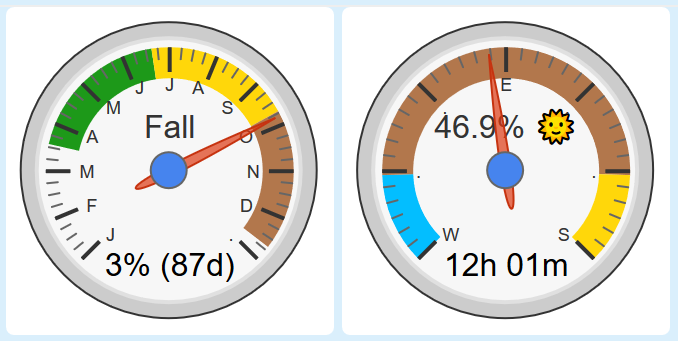
For my latitude, it typically balances out about 4 days afterwards.
(and for the the observant ones, the 12 hr mark at the Spring Equinox shifts in the other direction)
(IE: Summer to Fall delays a bit… Winter to Spring hits 12 hrs a bit early)
As I think more about it I guess this makes sense even though not intuitive. Intuitively, we would think at the equinox, the day and night would be equal but that only happens at the equator. Relative to our latitude, the sun goes farther south than it does north. The further south, however, has less impact on the day length. Maybe due to the earth getting “wider” to the south vs “narrower” to the north? Looking at my shortest day vs longest day, the shortest day is 2:17:58 less than 12 hours where my longest day is 2:36:55 more than 122 hours. A significant difference. SO, it is definitely ‘lopsided’ toward summer. Of course, that’s a good thing since I prefer light 
I did a little breakdown, out of curiosity…
Solstice to Solstice is almost exactly half a year:
~182 days = Winter Solstice > Summer Solstice
… but when we calculate where the Equinox is, it is not dead center:
~89 days = Winter Solstice > Spring Equinox
~93 days = Spring Equinox > Summer Solstice
… If we calculate from the 12 hour mark, it is even more skewed:
~85 days = Winter Solstice > 12 hour Mark
~97 days = 12 hour Mark > Summer Solstice
Depending on latitude, this last group of data can veer more (or less).
… or for the later half of the year:
~184 days = Summer Solstice > Winter Solstice
… which breaks down into:
~94 days = Summer Solstice > Fall Equinox
~90 days = Fall Equinox > Winter Solstice
… or comparing the 12 hour Mark:
~98 days = Summer Solstice > 12 hour Mark
~86 days = 12 hour Mark > Winter Solstice
I just learned something new after studying this image… (showing hours of daylight)
For a moment, just focus on the “12 line” in between these two colors:

This represents the equilux, or when & where in the world we can expect 12 hours days/nights…
Notice how north of the equator:
it happens a few days before the March Equinox, and a few days after the Sept Equinox.
What I just noticed is, for those south of the equator, it is inverted:
it balances a few days after the March Equinox, and a few days before the Sept Equinox.
…
But now that I think about it, it makes sense, since our Summer is their Winter.
It appears that, (based on the amount of daylight), everybody’s “Spring/Summer” is longer than “Fall/Winter”, no matter where in the world you live!
This absolutely blows my mind… Why is this not public knowledge?
It’s also fascinating how the farther away from the equator, the less you have to wait for the 12 hour day… but small changes take longer to notice than big changes… so this makes sense as well…
(IE: More abrupt changes at high latitudes, more subtle changes near the equator)
… Three hours later…
Sorry guys… I cannot turn this off… LOL
So I have combined the data from my last two posts, and reached yet another startling discovery…
OK, quick recap with this fuzzy thumbnail:
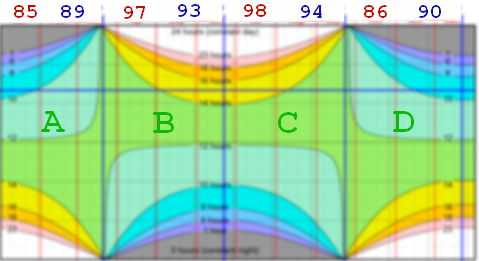
Solstices & Equinox are blue vertical lines. Blue numbers are the days between
B & C are about 4.5% longer durations than A & D
If we look at Solstices and Equilux, Red numbers are the days between.
(estimated for northern mid-latitudes)
B & C are about 7.6% longer durations than A & D
… but when we look south of the equator, here is where it gets interesting…
Alright, so we know a quarter year is about 91.31 days
… and we see that B & C are slightly more than this…
… and south of the equator, we see that the 12-hour mark angles up and down thru these latitudes…
So I would like to propose a better-worded theory…
When in the northern hemisphere, and
When measuring between the two Equilux…
The Spring/Summer duration is always longer than the Fall/Winter
(for my location, it is 195 vs 171 days)
… On the other hand…
When in the southern hemisphere, and
When measuring between the two Equilux…
The Spring/Summer duration is usually longer than the Fall/Winter
… but (and here is the addendum to my earlier statement), the extreme lower latitudes may actually have places where there are almost exactly six months between the two Equilux.
From these rough estimates, it looks like south of approx 45° S should be split fairly evenly.
To clarify, when comparing the space between Equinoxes (or Equiluxes), the only precise “half year” is about where my arrows are… (the Equilux date for extreme southern locations)
… I wonder if there is a name for this…
(Probably not though since Equilux wasn’t even coined until 2006)
Fascinating! Thanks for the detailed analysis. The patterns are there but the implications never seem to be obvious. This is really cool.
I could be mistaken, but after many hours of searching online, I think I can say with a fair amount of confidence that most of the observations in the last few posts are not documented publicly… Anywhere.
Which begs the question:
Can a “SmartHome AI” make a scientific discovery?!?
I mean, in all honesty, without that piston running, I would have never become aware of the shifts and discrepancies…
Welcome to “Darkember”…
… Tomorrow begins the three month period with the least amount of sunlight…
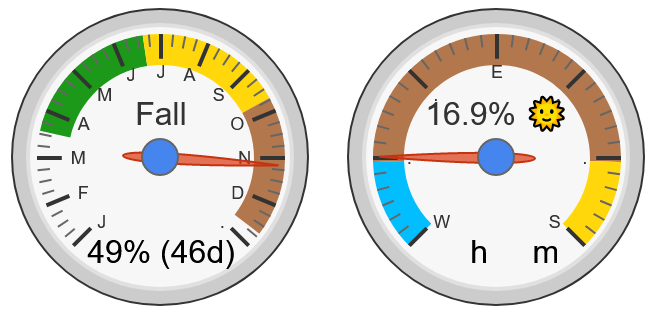
Well, we are ten days away from the Winter Solstice, and the dayLength is already less than 1%.
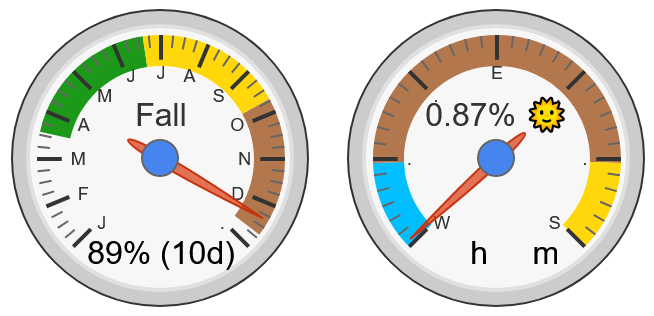
This means over the next 3 weeks, the dayLength will barely change.
I am probably a bit early, but in case I forget…
Don’t forget to calibrate your shortest day (as seen by TWC) on the Winter Solstice.
If you are busy, at least write the data down on that day.
(You can always calibrate later)
In 2020, the Solstice is precisely:
Monday, December 21, at 10:02 UT
but you can take a reading on whatever day that falls on…
(anytime between 12:20am and 11:50pm will work)
Just calibrated my gauges. Had to update by about 30 seconds. I think both solstices are calibrated now. 
Prior to update:
After update:
Thanks!
EDIT: Interesting note. I have this set up for the house my kids live in in another city. It is only about 250 miles from my house but the day length difference today is 11 minutes, 28 seconds. Always surprised how big a difference there is over relatively small distances. At the equinox, the difference was nearly 0.